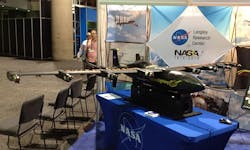NASA-developed distributed electric propulsion could be key to future ultra-quiet UAV
Researchers at the National Aeronautics and Space Administration (NASA) have developed a scale model of what they call distributed electric propulsion, and now are moving to general aviation-scale prototype aircraft with this ultra-quiet UAV propulsion technology.
The testbed for distributed electric propulsion is called the GL-10 -- short for Greased Lightning -- a 10-motor small unmanned aerial vehicle (UAV) with low-speed 18-inch propellers that developers say is inaudible to human ears when operating at altitudes as low as 100 feet above the ground.
Developing distributed electric propulsion technology are aviation researchers at the NASA Langley Research Center in Hampton, Va. They were showing the GL-10 demonstrator UAV this week at the Association for Unmanned Vehicle Systems International (AUVSI) 2015 conference and trade show in Atlanta.
The GL-10 prototype has 10 8-horsepower electric motors -- eight on the wings and two on the tail. The next project involving distributed electric propulsion will be a 3,000-pound four-passenger aircraft with a 31-foot wing span, says Mark Moore, the GL-10's project lead at NASA Langley.
Standard fast-moving propellers on most small UAVs like the ubiquitous quad copter generate harmonics that translate into relatively loud noise -- even if the drone's propellers and air frames generate little if any noise. The movement of air is the source of the noise.
Distributed electric propulsion on the GL-10, however, uses slow-moving props with digital control that spin at slightly different RPMs to break up the big harmonics of standard propellers into a lot of different harmonics spread over all the motors, Moore says.
This approach with digitally controlled motors moving at slightly different speeds is called speed frequency shifting, Moore says. "We can fly this over at 100 feet without being able to hear it on the ground," he says. "We're targeting package delivery and privacy, and no-noise-nuisance applications."
Related: Puma miniature UAV lands on water and ground for special forces applications
The basis for ultra-quiet aircraft propulsion like the GL-10's distributed electric propulsion is not new, Moore says. It came from Vietnam War-era research that led to the YO-3A Quiet Star aircraft, developed by Lockheed Corp. in the late 1960s for covert battlefield observation -- particularly at night, Moore says.
The manned YO-3A aircraft reportedly was inaudible from the ground when flying at altitudes as low as 1,200 feet. The last YO-3A was sold at auction in the early 2000s, but not before being used by the Louisiana Department of Fish and Game to help catch poachers.
Ultimately this approach could lead to reduced-annoyance UAVs that can operate unobtrusively in densely populated areas, as well as provide the propulsion technology for covert and stealthy reconnaissance and surveillance UAVs.
For more information contact NASA Langley Research Center online at www.nasa.gov/langley.
